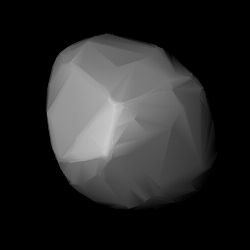|
873 Mechthild
873 Mechthild (prov. designation: A917 KJ or 1917 CA) is a dark background asteroid from the central regions of the asteroid belt. It was discovered by German astronomer Max Wolf at the Heidelberg Observatory on 21 May 1917.[1] The primitive P-type asteroid has a rotation period of 11.0 hours and measures approximately 34 kilometers (21 miles) in diameter. The origin of the asteroid's name remains unknown.[2] Orbit and classificationMechthild is a non-family asteroid of the main belt's background population when applying the hierarchical clustering method to its proper orbital elements.[4][5] It orbits the Sun in the central asteroid belt at a distance of 2.2–3.0 AU once every 4 years and 3 months (1,555 days; semi-major axis of 2.63 AU). Its orbit has an eccentricity of 0.15 and an inclination of 5° with respect to the ecliptic.[3] The body's observation arc begins with its first and official discovery observation at Heidelberg Observatory on 21 May 1917.[1] NamingThis minor planet is named "Mechthild", a German feminine given name. Any reference of this name to a specific person or occurrence is unknown.[2] Unknown meaningAmong the many thousands of named minor planets, Mechthild is one of 120 asteroids, for which no official naming citation has been published. All of these low-numbered asteroids have numbers between 164 Eva and 1514 Ricouxa and were discovered between 1876 and the 1930s, predominantly by astronomers Auguste Charlois, Johann Palisa, Max Wolf and Karl Reinmuth.[10] Physical characteristicsIn the Tholen classification, Mechthild is closest to a very dark, primitive P-type, and somewhat similar to a common C-type asteroid. In the taxonomy by Barucci, it is a C0-type.[3][5] P-type asteroids are more common in the outer asteroid belt and among the Jupiter trojan population. Rotation periodIn May 2015, a rotational lightcurve of Mechthild was obtained from photometric observations by Brian Warner at his Palmer Divide Observatory (716) in Colorado. Lightcurve analysis gave a rotation period of 11.006±0.001 hours with a brightness amplitude of 0.27±0.02 magnitude (U=3).[9] Alternative period determinations were made by Claes-Ingvar Lagerkvist (10.6 h) in March 1976, by astronomers at the Palomar Transient Factory (11.007±0.0069 h) in January 2014, and by the Spanish group of asteroid observers, OBAS (10.99±0.01 h) in May 2015 (U=2/2/3).[11][12][13] In 2016, a modeled lightcurve gave a concurring sidereal period of 11.00639±0.00005 hours using data from a large collaboration of individual observers (such as above). The study also determined two spin axes of (249.0°, −52.0°) and (51.0°, −61.0°) in ecliptic coordinates (λ, β).[14] Diameter and albedoAccording to the surveys carried out by the Infrared Astronomical Satellite IRAS, and the Japanese Akari satellite, and the NEOWISE mission of NASA's Wide-field Infrared Survey Explorer (WISE), Mechthild measures (29.04±1.9), (33.56±0.59) and (34.471±0.103) kilometers in diameter and its surface has an albedo of (0.0531±0.008), (0.041±0.002) and (0.040±0.004), respectively.[6][7][8] The Collaborative Asteroid Lightcurve Link adopts the results from IRAS, that is, an albedo of 0.0531 and a diameter of 29.04 kilometers based on an absolute magnitude of 11.49.[15] Alternative mean-diameter measurements published by the WISE team include (29.124±10.26 km) and (36.327±0.290 km) with corresponding albedos of (0.0785±0.0687) and (0.0339±0.0063).[15] References
External links
|
||||||||||||||||||||||||||||||||||||||||||||||||||||||||||||||||
